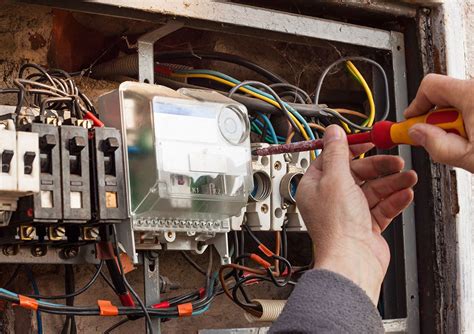Professional Solutions for Electrical System Troubleshooting and Repairs
Reliable troubleshooting and fixing of electrical systems require a systematic strategy, leveraging both progressed analysis devices and skilled know-how. Common issues such as circuit overloads and defective wiring need immediate focus, yet the complexities of electric systems can often obscure the hidden troubles. Safety and security protocols are vital, as also minor oversights can result in significant risks. Comprehending when to involve a professional can make all the distinction in ensuring both safety and security and system integrity. As we discover the vital aspects of electric troubleshooting, the ramifications of ignoring these best methods end up being progressively noticeable.

Usual Electric Issues
While electrical systems are created for dependability, they can often encounter a variety of usual issues that might interrupt capability and safety. One widespread concern is circuit overload, which happens when way too many devices draw power from a solitary circuit, causing tripped breakers or blown integrates. technical support for electrical industry. This can not only hinder electrical performance however additionally position a fire danger
Another frequent trouble is defective wiring, typically due to age, wear, or improper installment. Damaged or frayed cords can lead to brief circuits, resulting in interruptions or electrical shocks. Additionally, loose links can cause periodic power loss, developing discouraging and possibly hazardous scenarios.
Ground faults are one more worry, especially in wet or wet atmospheres where electric equipment is used. These mistakes can cause major security threats, demanding prompt focus to ensure correct grounding and circuit protection.
Last but not least, flickering lights can show concerns ranging from overloaded circuits to faulty light components. Identifying these typical electrical issues is critical for keeping the integrity and security of electrical systems, ensuring they operate effectively and successfully. Attending to these problems without delay can stop extra severe issues and enhance total system integrity.
Analysis Tools and Techniques
Employing accurate diagnostic devices and techniques is necessary for successfully identifying and fixing electric system issues. Different instruments help with precise assessments, varying from basic multimeters to advanced oscilloscopes - technical support for electrical industry. Multimeters are basic for measuring voltage, current, and resistance, allowing specialists to rapidly pinpoint faulty elements or connections
Clamp meters are particularly helpful for gauging current without disrupting the circuit, improving safety and security during diagnostics. For more complicated troubleshooting, oscilloscopes permit the visualization of electric signals over time, supplying understandings into waveform anomalies that may suggest underlying issues.
Along with these tools, infrared thermography is important for identifying overheating elements, which can indicate upcoming failures. Insulation resistance testers additionally assist in recognizing jeopardized insulation, crucial for protecting against electrical hazards.
Methods such as visual examinations, continuity examinations, and circuit tracing are additionally essential to an effective analysis process. By integrating these devices page and techniques, specialists can develop a comprehensive understanding of electrical systems, guaranteeing precise diagnoses and effective fixings. Inevitably, leveraging the appropriate analysis resources not only improves troubleshooting performance but also adds to the longevity and safety and security of electrical setups.
Step-by-Step Troubleshooting Overview

Following, utilize diagnostic tools such as multimeters and circuit testers to inspect for connection, voltage, and current flow in the circuit. Begin at the source of power, confirming that it is operational, then trace the circuit step by step, examining each part along the means. File your searchings for to maintain clearness throughout the procedure.
Once you have recognized the defective part, separate it from the circuit. Carry out needed repair work or substitutes, ensuring that all circuitry and links are secure. After dealing with the concern, recheck the whole system to confirm that it operates correctly.
Safety And Security Precautions During Repair Services
Ensuring safety during electrical repairs is vital to avoid mishaps and injuries. Prior great post to read to starting any job, it is important to transform off the power supply at the breaker and verify that the circuit is de-energized utilizing a dependable voltage tester. Personal safety devices (PPE), including insulated handwear covers and safety goggles, need to be used to alleviate the threat of electric shock and eye injuries.
Utilizing tools with insulated takes care of can additionally enhance safety and security. It is also essential to avoid working on electrical systems in damp or damp problems, as dampness dramatically increases the danger of electrical shock.
Secure loose apparel and tie back lengthy hair to prevent any complexity with electric components. Acquaint yourself with the details electrical codes and policies appropriate to your location to ensure conformity and safety during the repair work procedure.
When to Call a Professional
While safety and security preventative measures are essential for check my blog any type of electric fixing, there are scenarios where the intricacy or range of the work demands the competence of a specialist electrician. Property owners need to be especially mindful when dealing with concerns that include breaker, electrical panels, or the primary power supply. Any type of indicators of electrical fires, such as burnt scents or flickering lights, warrant instant expert focus.
Additionally, if you run into consistent tripping of breaker or constant electrical surges, these may indicate underlying issues that need specialized analysis tools and expertise. Projects that demand extensive rewiring, setup of brand-new circuits, or links to high-voltage systems should always be delegated qualified electrical experts, as incorrect handling can result in extreme hazards.
In addition, regulative compliance is important in electrical job. Experts know with regional codes and guidelines, making certain that all fixings meet safety standards. Finally, if you're ever before unsure regarding your abilities or the severity of the problem, err on the side of care and speak with a certified electrical contractor. Prioritizing safety and security and reliability will ultimately protect both your building and health.
Conclusion
In final thought, efficient repairing and fixing of electric systems need an organized technique, leveraging innovative analysis devices and adherence to security preventative measures. By identifying typical electrical troubles and employing a structured troubleshooting guide, many issues can be settled efficiently.